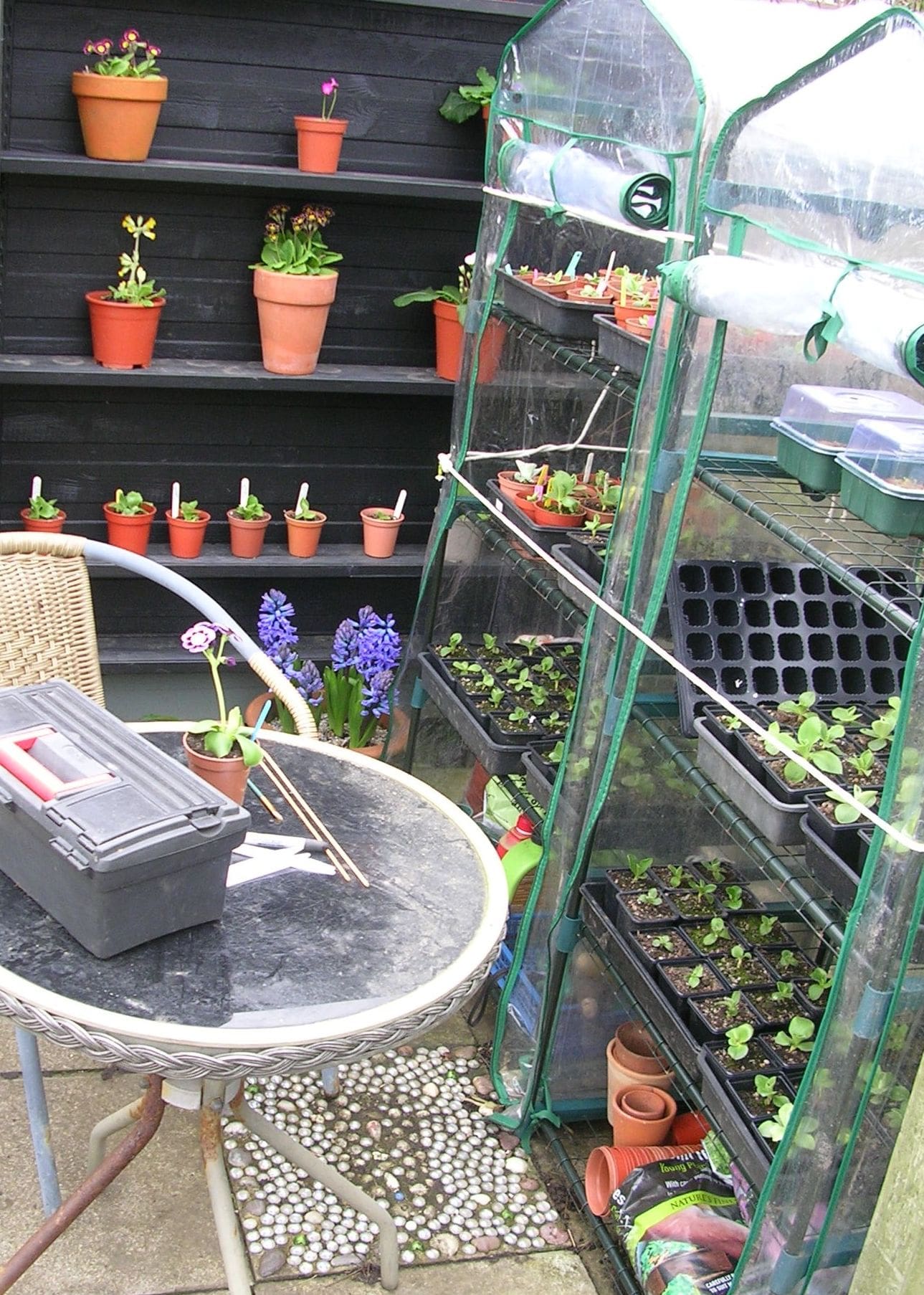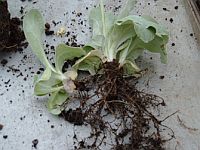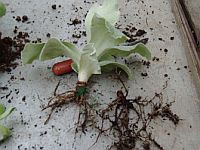
Northern Section
Northern Section
AURICULA GROWING GUIDE
Where to Grow?
Auriculas are spring flowering plants, originating from the Alps, making them very hardy. Best results are obtained growing them in small pots under cover, with the exception of Border Auriculas that can be grown in the open garden.
The ideal place to grow auriculas, is in an unheated greenhouse with good ventilation. However mini greenhouses, cold frames or a small table on a city centre balcony are suitable.
Ensure that overhead protection is provided to shelter from heavy rain, especially in winter. Direct summer sun should be avoided, use greenhouse shade netting as a curtain where needed.
The best aspect to place your chosen growing areas are west or east facing. North facing provides too little light, and south facing results in too much light and heat in summer. Year round ventilation is essential to protect from disease and rot.

Pots and Compost
Auriculas should be grown in as small a pot as possible to keep their roots restricted. A 9cm (3½") pot is normally the maximum size used for shows.
Plastic and terracotta pots are both suitable; plastic are easier to clean and do not dry out as quickly.
Composts for Auriculas must be free draining to avoid roots sitting in wet heavy compost, which can cause rot and decay. You won't go far wrong with a basic mix of equal parts multi-purpose compost; John Innes No. 2 compost and horticultural grit. Use only the best ingredients, it's not worth using cheap composts.
Feeding & Watering
Over-watering is the easiest way to kill Auriculas.
The amount of water needed varies throughout the year, see Seasonal Care Guide, but less is best.
It can be difficult to determine how much moisture is in the compost. Try judging the weight of the pot by lifting it, after a little practice it will give you a good indication.
Feeding is another issue where less is best. Overfeeding will produce flowers out of character for show standards. It is recommended to provide a spring feed as growth re-starts, a quarter strength tomato feed or liquid seaweed applied twice during March may encourage the required flower production.
Re-potting
The only way to reproduce an Auricula true to its parent is by taking off-sets from that parent. This can be carried out at any time whilst the plant is actively growing.
However probably the best time to take off-sets is whilst re-potting. Tease off any rooted off-sets from the main stem (known as the carrot), as Figures 1 and 2, and pot on in 6 or 8cm pots. If there are a few off-sets from the same variety, they can also be potted up in a larger pot around the edges. Water from the bottom to avoid air pockets around the roots.


Prior to re-potting, ensure that the pots to be used have been cleaned.
Re-potting provides an opportunity to remove off-sets to propagate further plants; check for pests and diseases; and replace the compost and nutrients. This is best done immediately after flowering (unless you are growing for seed); or late July/early August.
Take the plant from its pot, remove all the compost and dispose of. Using this old compost on your garden could spread disease. Inspect the carrot and roots for decay and pests (root aphis and vine weevil being the worst). Shorten the carrot back to clean flesh, this also stimulates fresh roots higher up the carrot.
Using only freshly mixed compost and clean pots, re-pot ensuring no air pockets are left around the roots. Water well and store in the shade to recover, ensuring they do not dry out. This balancing of compost moisture content is most important - not too dry but more important not too wet!
Pests and Diseases
Like all plants, Auriculas are liable to attack from pests and diseases, the best way of preventing this is by constant vigilance to spot and treat the problem early.
Vine Weevil is probably the most serious of the pests, where the grub eats all the roots, killing the plant. The first indication tends to be when the plant remains limp after watering. If Vine Weevil is suspected, try searching for the beatle in the dark with a torch. A good tip from one of our most experienced growers. Control is by the use of systemic insecticides or biological nematodes.
Root aphis identified by a white fluffy deposit, often found around the neck of the carrot at soil level and/or around the roots when removed from the pot. Whilst common it is rarely fatal, wash the affected areas with soapy water using a small brush.
Red Spider Mite a tiny insect that can be very difficult to get rid of. They prefer hot dry conditions, with the cycle of generations increasing with the temperature. Spray the greenhouse floor with water to keep temperatures down and humidity up.
Caterpillars are often found hiding in the foliage so constant vigilance is required.
Botrytis is a fungus that affects many plant species, it is sometimes called "grey mould" and the spores can spread rapidly. Remove all dead leaves regularly and dispose of, ensure that there is adequate ventilation.
Seasonal Care
The timings stated below are a guide only and can vary from year to year depending upon the winter/spring weather. Variations must also be allowed for as to your own location in the country.
After flowering may seem strange to start the year at this point, however the care and attention needed to produce the best plants for the show bench starts here. Unless you want to produce seed from a plant:-
- remove dead flowers but not the stem, allow this to die back naturally before removing.
- re-pot plants using fresh compost, inspect for damage and pests. Alternatively this can be carried out in August.
- remove and pot on any off-sets into small pots, remember to label with variety name.
- pot on last seasons off-sets using a larger pot if required.
Summer Months
- during the hottest months, plants suffer from the heat, so keep them as cool as possible with shading and good ventilation. Placing the plants outside in a shaded part of the garden or a cold frame will help.
- keep plants moist but not wet.
- inspect regularly for pests and diseases.
- water greenhouse floors in the morning and evening to keep temperatures down.
- protect outside plants from heavy rain.
Autumn
- harvest seed when pods turn light brown and start to split, place in small paper bags inside an old jam jar and store in the refrigerator (not freezer).
- pot on small plants as they outgrow their pots.
- re-pot plants not re-potted earlier in the year.
- remove greenhouse shading as temperatures and light levels drop. Clean glass and benches before winter.
- return outside plants to the greenhouse in October.
Late Autumn/Early Winter
- plants will go into a short dormant stage, reduce water to a minimum.
- ventilation is still essential.
- plants will start to lose some leaves as they turn yellow, resist the temptation to remove these leaves immediately, but keep an eye open for botrytis.
- sow seed in October.
Winter
- ventilation is still essential, do not attempt to protect from frost.
- reduce watering to a minimum keeping compost just dry but not dust dry.
- if not sown in October, sow seed in January.
February
- as plants show signs of spring growth, gradually increase watering to keep compost only just moist.
- remove top 2cm of compost and replace with fresh. Remove any viable off-sets and pot on.
March
- give two feeds of 1/4 strength tomato feed or liquid seaweed to encourage flower growth.
- Shade green house towards the end of month as light levels increase.
- prick out seedlings into trays or pots as they grow.
- select flowering plants for showing, clean and prepare to show them to best effect.
- select flowering seedlings from the previous years sowing that are of show standard, dispose of the others or give them away to friends, you will very quickly run out space otherwise.
- select plants in flower for seed production and cross pollinate.
